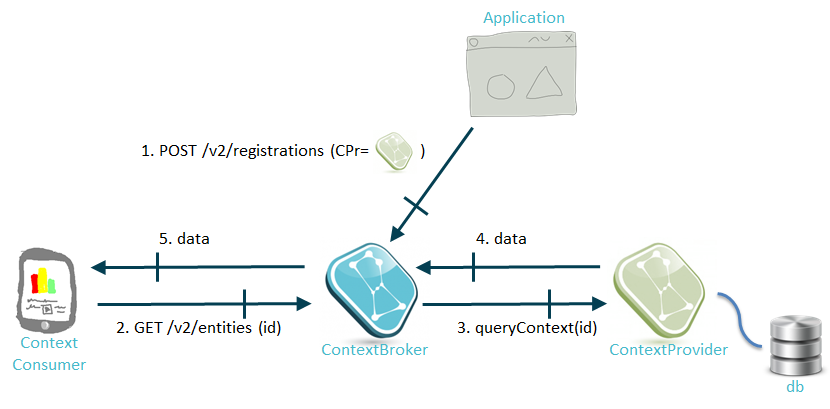Context Providers registration and request forwarding
The register context operation (both in NGSIv1 and NGSIv2) uses the concept of "context provider" which is a URL that identifies the source of the context information for the entities/attributes included in that registration.
In the case of NGSIv2, this is provided by the field provider:
...
"provider": {
"http": {
"url": "http://mysensors.com/Rooms"
}
}
...
In the case of NGSIv1, this is provided by the field providingApplication
...
"providingApplication" : "http://mysensors.com/Rooms"
...
If Orion receives a query or update operation (either in the standard or in the convenience family) and it cannot find the targeted context element locally (i.e. in its internal database) but a Context Provider is registered for that context element, then Orion will forward the query/update request to the Context Provider. In this case, Orion acts as a pure "NGSI proxy" (i.e. doesn't cache the result of the query internally) and, from the point of view of the client issuing the original request, the process is mostly transparent. The Context Provider is meant to implement the NGSI10 API (at least partially) to support the query/update operation.
Let's illustrate this with an example.

- First (message number 1), the application (maybe on behalf of a Context Provider) registers the Context Provider at Orion for the Street4 temperature. Let's assume that the Context Provider exposes its API on http://sensor48.mycity.com/v1
curl localhost:1026/v2/registrations -s -S -H 'Content-Type: application/json' -H 'Accept: application/json' -d @- <<EOF
{
"dataProvided": {
"entities": [
{
"id": "Strret4",
"type": "Street"
}
],
"attrs": [
"temperature"
]
},
"provider": {
"http": {
"url": "http://sensor48.mycity.com/v1"
},
"legacyForwarding": true
}
}
EOF
- Next, consider that a client queries the Street4 temperature (message number 2).
curl localhost:1026/v2/entities/Street4/attrs/temperature?type=Street -s -S \
-H 'Accept: application/json' -d @- | python -mjson.tool
- Orion doesn't know the Street 4 temperature, but it knows (due to the registration in the previous step) that the Context Provider at http://sensor48.mycity.com/v1 does know about the Street 4 temperature, so it forwards the query (message number 3) to the URL http://sensor48.mycity.com/v1/queryContext (i.e. the URL used in the Providing Application field at registration time, plus the "/queryContext" operation). Note that the query is forwarded using NGSIv1 format although the original request from the client used NGSIv2 (this is due to lack of support for NGSIv2 based forwarding, see this issue about it).
{
"entities": [
{
"type": "Street",
"isPattern": "false",
"id": "Street4"
}
],
"attributes": [
"temperature"
]
}
- The Context Provider at http://sensor48.mycity.com/v1 responds with the data (message number 4).
{
"contextResponses": [
{
"contextElement": {
"attributes": [
{
"name": "temperature",
"type": "float",
"value": "16"
}
],
"id": "Street4",
"isPattern": "false",
"type": "Street"
},
"statusCode": {
"code": "200",
"reasonPhrase": "OK"
}
}
]
}
- Orion forwards the response to the client (message number 5).
{
"value": 16,
"type": "Number
}
Some additional comments:
- The
-httpTimeoutCLI parameter is used to set the CPr timeout. If a request forwarded to a CPr is taking more that that timeout, then Orion closes the connection and assumes that the CPr is not responding. - In the case a given request involves more than one Context Provider (e.g. an updateContext including 3 context elements, each one being an entity managed by a different Context Provider), Orion will forward the corresponding "piece" of the request to each Context Provider, gathering all the results before responding to the client. Current implementation process multiple forwards in sequence, i.e. waiting the response from a given CPr (or timeout expiration) before sending the forward request to the following.
- You can use the
-cprForwardLimitCLI parameter to limit the maximum number of forwarded requests to Context Providers for a single client request. You can use 0 to disable Context Providers forwarding at all. - In NGSIv1 registrations,
isPatterncannot be set to"true". If so, the registration fails and an error is returned. The OMA specification allows for regular expressions in entity id in registrations but as of now, the Context Broker doesn't support this feature. - You should include entity type in the query/update in order for the ContextBroker to be able to forward to Context Providers. Otherwise you may encounter problems, like the one described in this post at StackOverflow.